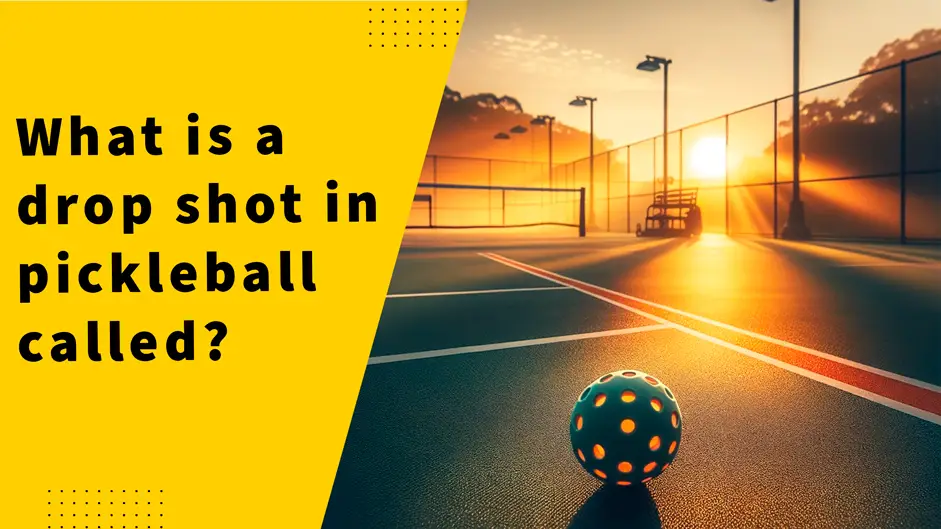
Pickleball, a sport that combines elements of tennis, badminton, and table tennis, has seen a remarkable surge in popularity. Among the arsenal of shots that players have at their disposal, the drop shot holds a special place for its strategic depth and the finesse required to execute it effectively. This guide dives deep into mastering the drop shot, a skill that can significantly elevate your game.
Understanding the Drop Shot
The drop shot in pickleball is a delicate, softly hit ball that barely clears the net, designed to land in the opponent’s non-volley zone (also known as the kitchen), making it difficult for them to return with power. The beauty of a well-executed drop shot lies in its subtlety and the strategic advantage it provides, forcing opponents out of their comfort zone and into a less advantageous position on the court.
What Is a Drop Shot?
At its core, a drop shot is a strategic play that requires precision and control. Unlike power shots that rely on speed and force, the drop shot is all about finesse and placement. The objective is to make the ball arc gently over the net, landing softly in the kitchen, ideally in a spot that is difficult for your opponent to reach without stepping into the non-volley zone.
The Purpose and Strategic Advantage
The drop shot serves multiple strategic purposes. It can:
- Break the rhythm of opponents who prefer a fast-paced, power-driven game.
- Bring opponents to the net, setting up opportunities for lob shots or passing shots.
- Create openings in your opponents’ court positioning, allowing you to take control of the rally.
The strategic advantage of mastering the drop shot cannot be overstated. It adds a layer of complexity to your game, making you unpredictable and forcing your opponents to play on your terms. Whether you’re a beginner looking to expand your shot repertoire or an experienced player aiming to refine your skills, understanding and mastering the drop shot is a step toward elevating your pickleball game.
Great! Moving on, let’s delve into the specifics of executing the drop shot, with a focus on the art of the third shot drop, which is a critical component of high-level pickleball play.

The Art of the Third Shot Drop
In pickleball, the third shot of a point—the first shot after the serve and return—is pivotal in setting the tone for the rally. The third shot drop is a technique that, when mastered, can significantly shift the dynamics in your favor. This section explores the significance, execution techniques, and common mistakes associated with this crucial shot.
Significance of the Third Shot Drop
The third shot drop serves as a bridge between the initial serve and return and the nuanced net play that characterizes high-level pickleball. It allows the serving team to transition from the baseline to the net, positioning themselves for offensive play. A well-executed third shot drop forces the receiving team to hit an upward shot in response, creating opportunities for the serving team to seize control of the rally.
Execution Techniques
Mastering the third shot drop requires practice and attention to several key factors:
- Body Positioning: Start behind the baseline with your knees slightly bent and your body weight on your toes, ready to move forward. Your position should allow you to step into the shot, using your body momentum to add control and finesse.
- Paddle Grip and Swing: Use a continental grip for versatility. The swing should be smooth and controlled, with the paddle face slightly open to ensure the ball arcs gently over the net.
- Point of Contact: Strike the ball at its highest point that still allows you to angle it downwards into the kitchen. The aim is to create a trajectory that makes it difficult for opponents to attack.
Common Mistakes and How to Avoid Them
Many players struggle with the third shot drop when they first attempt to integrate it into their game. Here are common pitfalls and how to avoid them:
- Hitting Too Hard: The most frequent mistake is applying too much power, sending the ball either into the net or too deep, making it easy for opponents to attack. Focus on softening your grip and using a gentle swing.
- Poor Footwork: Good footwork is essential. Practice moving your feet to position yourself optimally for the shot, avoiding reaching or stretching, which can lead to loss of control.
- Lack of Practice: Like any advanced technique, the third shot drop requires consistent practice. Drill with a partner or coach, focusing on placement and control rather than power.
Drop Shot Variations and When to Use Them
Beyond the basic third shot drop, there are variations that can add depth to your game. Understanding when and how to use these can keep your opponents guessing and off-balance.
Flat Drop Shot
Ideal for when you’re closer to the net and need a shot that minimizes bounce, making it harder for opponents to lift the ball without hitting a fault in the non-volley zone.
Slice Drop Shot (Backspin)
The slice adds backspin to the ball, causing it to slow down upon bouncing and stay low, challenging the opponent to hit a good return. It’s particularly effective in windy conditions or when the ball is hit from a higher point.
Topspin Drop Shot
A topspin drop shot causes the ball to bounce forward, potentially forcing the opponent to hit on the move or deal with an awkward bounce. It’s a more advanced shot that requires precise timing and control.
Understanding these variations and incorporating them into your practice can significantly enhance your strategic options during play.
Executing the Perfect Drop Shot
Achieving proficiency in the drop shot requires understanding its mechanics and engaging in deliberate practice. Here’s how to fine-tune your technique for both forehand and backhand drop shots.
Forehand Drop Shot
- Body Positioning: Align your body parallel to the net, with your non-paddle foot slightly forward. This stance allows for better control and directional accuracy.
- Paddle Grip and Swing: Maintain a loose grip on the paddle for better feel and control. Initiate the swing with a slight shoulder turn and a compact arm movement, ensuring the paddle face is open at the point of contact to guide the ball gently over the net.
- Point of Contact: Hit the ball in front of your body, aiming for a low-to-high trajectory to clear the net while minimizing bounce.
Backhand Drop Shot
- Body Positioning: Similar to the forehand, ensure your body is side-on to the net. The backhand drop shot often requires more wrist flexibility to achieve the desired paddle angle.
- Paddle Grip and Swing: The backhand grip should allow for a comfortable swing with the back of the hand leading. The motion should be fluid, with a focus on guiding the ball rather than hitting it.
- Point of Contact: The ball should be struck slightly later than the forehand drop shot, allowing for better control over the shot’s direction and depth.
Drills and Tips for Improving Your Drop Shot
Improvement comes with practice. Here are some drills and tips to enhance your drop shot skills:
Solo Drills
- Wall Drills: Practice hitting drop shots against a wall, focusing on control and consistency. Aim for a specific spot to improve accuracy.
- Target Practice: Set up targets in the non-volley zone and practice hitting them from the baseline. This drill helps with depth control and precision.
Partner Drills
- Cross-Court Drops: With a partner, practice hitting cross-court drop shots from the baseline, aiming to land them in the non-volley zone. This drill improves shot placement and consistency under more realistic conditions.
- Live Point Play: Engage in point play where the only groundstroke allowed is the drop shot. This practice scenario emphasizes strategic use and execution under pressure.
The Psychological and Strategic Edge of Drop Shots
The mental game is as crucial as physical skill in pickleball. Successfully integrating drop shots into your game plan requires not just technical proficiency but also strategic acumen and psychological readiness.
- Surprise Element: Use the drop shot to disrupt your opponents’ rhythm and force them into a defensive position. The element of surprise can be a powerful tool, especially against power hitters.
- Patience is Key: Developing a good drop shot demands patience, both in practice and during match play. Resist the urge to rush points and instead focus on building opportunities to use your drop shot effectively.
- Mental Flexibility: Be prepared to adapt your strategy based on the effectiveness of your drop shots. If opponents start anticipating your drops, be ready to switch tactics, using drives or lobs to keep them off balance.
By incorporating these drills and mental strategies into your practice routine, you’ll not only improve your drop shot but also enhance your overall game intelligence and psychological resilience on the court.
FAQ: Drop Shot in Pickleball
Q1: Can beginners successfully learn and implement the drop shot in their game?
A: Absolutely. Beginners are encouraged to start practicing the drop shot early in their pickleball journey. With consistent practice and attention to technique, players at any level can effectively integrate the drop shot into their game.
Q2: How does wind affect the execution of a drop shot in outdoor pickleball games?
A: Wind can significantly impact the flight and landing of a drop shot. Players need to adjust their aim and the strength of their shot based on wind direction and intensity. Practicing in various wind conditions can help develop this adaptability.
Q3: Is there a difference in drop shot technique when playing singles vs. doubles in pickleball?
A: Yes. In singles, you have more court to cover, so placement becomes even more crucial. In doubles, coordination with your partner and strategic placement to split the opposing team or target their weaker player becomes key. The fundamental technique remains the same, but the strategic application varies.
Q4: How important is the paddle’s quality in executing an effective drop shot?
A: While technique is paramount, a quality paddle can enhance feel and control, making it easier to execute precise drop shots. Paddles with a softer touch tend to offer better control for finesse shots like the drop.
Q5: Are there specific exercises to improve wrist flexibility and strength for better drop shots?
A: Yes, exercises like wrist curls, reverse wrist curls, and grip strengtheners can improve wrist strength and flexibility, contributing to more controlled and effective drop shots.
Q6: How do you adjust your drop shot technique on different pickleball court surfaces?
A: Different surfaces can affect the bounce and speed of the ball. On harder surfaces, you might need to soften your shot more than on softer surfaces like grass. Adjusting the paddle angle and the force used is key to adapting your drop shot technique to different surfaces.
Q7: What’s the best way to practice drop shots if you don’t have a regular playing partner?
A: Practicing against a wall or using a ball machine can be effective for honing your drop shot technique. Focus on consistency, placement, and controlling the ball’s height and speed.
Q8: Can using a drop shot be effective against power players?
A: Yes, the drop shot can be a great equalizer against power players. By forcing them to move forward and play a soft ball, you can disrupt their rhythm and take control of the point.
Q9: How do I know if I’m overusing the drop shot in my game?
A: If opponents begin to anticipate and counter your drop shots effectively, it may be a sign to vary your shot selection. Mixing in drives, lobs, and volleys can keep your game unpredictable.
Q10: Are there any mental tips for maintaining confidence in using drop shots during high-pressure points?
A: Focus on the process rather than the outcome. Visualize successful drop shots during practice, and apply a routine before executing the shot in games to build confidence. Remember, even professional players miss shots; the key is consistency and not letting one mistake affect the next shot.
Conclusion
Concluding our journey through the intricacies of mastering the drop shot in pickleball, it’s clear that this skill is more than just a technique; it’s a strategic tool that, when wielded with precision and thoughtfulness, can significantly elevate a player’s game. From understanding the fundamentals of executing a perfect drop shot to exploring advanced drills and psychological tactics, we’ve covered a broad spectrum of insights designed to enhance your performance on the court.
The drop shot, with its ability to disrupt the rhythm of the game and force opponents into challenging positions, is a testament to the strategic depth of pickleball. As we’ve seen, mastering this shot requires a blend of technical skill, strategic thinking, and mental resilience. It’s not just about making the ball clear the net and land softly in the non-volley zone; it’s about doing so with intention, adapting to the dynamics of each match, and continuously seeking ways to integrate this tool into a comprehensive game plan.
Remember, the path to mastery is a journey, not a destination. Each practice session, each drill, and each match is an opportunity to refine your skills, learn from your experiences, and grow as a player. Embrace the challenges and setbacks as part of the learning process, and celebrate the victories, no matter how small, as milestones on your journey.
In closing, whether you’re a novice picking up a paddle for the first time or an experienced player aiming to deepen your strategic arsenal, the drop shot offers a world of potential to explore. Dedicate yourself to practice, stay patient and persistent, and most importantly, enjoy the journey. The skills and confidence you build along the way will not only enhance your prowess with the drop shot but also enrich your overall experience and enjoyment of the beautiful game of pickleball.
As we part ways with this guide, I encourage you to take these insights and strategies to the court. Experiment, adapt, and refine your approach to the drop shot, and always keep an open mind to learning and improvement. The journey to mastering the drop shot in pickleball is a rewarding one, filled with growth, challenge, and the joy of playing a game we love. Here’s to your success, on and off the court!

I am Michael Wanner, an experienced and educated expert in the field of pickleball. I hold a degree in Sports Science from Cleveland State University, Ohio, USA. My expertise lies in the technical aspects of pickleball and how to play it effectively. I have spent many years playing and coaching pickleball and have a wealth of knowledge to share with my readers. I am a valuable resource for anyone looking to improve their pickleball skills and strategies.